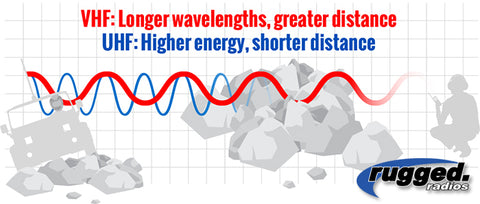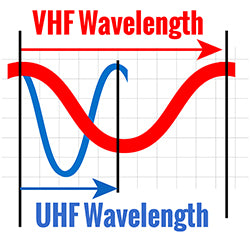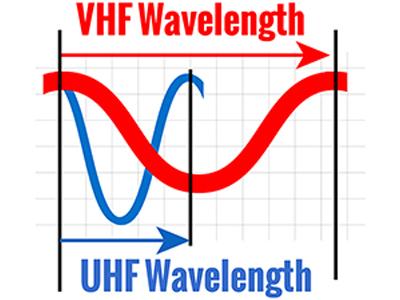
This may qualify under the heading of “more than you need to know”, but if you’re curious to understand the nuances of radio communications, you may find this helpful.
When it comes to choosing the right radio, one of the most difficult decisions to make is which bandwidth to utilize. The two major wavelengths used in vehicle to vehicle, or vehicle to base communications are VHF (Very High Frequency) and UHF (Ultra High Frequency). The differences between these bands may not seem that important, but when you have an incident that requires emergency communication, the last thing you need to worry about is your radio’s range.

One difference between the two bands is of course the frequency. Radio waves are a form of light, therefore all radio waves travel at the same speed. This matters because the different radio waves aren’t measured by their speed, they must be measured by their “waves”. Imagine radio waves as water waves. The distance between the tops of the waves is of course the “wavelength”, and the amount of waves that pass a certain point over 1 second is called the “frequency” (measured as Hertz). When something has higher hertz, it means its “wavelength” must be shorter. This is because while the light always travels the same speed the only way to fit more waves in a period of time is to have smaller waves.
VHF
VHF’s frequency range is from 30 MHz to 300 MHz. Compared to UHF’s range, which is 300 MHz to 3000 MHz, it’s clear that VHF has sometimes 10 times longer wavelengths. This means that since the waves are longer with VHF, it’s harder to disrupt the wave, therefore it travels further. Imagine a large wave hitting a rock as opposed to a small one. The larger wave is still able to make it over or around the rock, while the smaller wave is drastically deflected leaving less water to go around the rock. UHF has a higher frequency so it has smaller waves, making it easier for the waves to degrade over distance.

UHF
So you may be wondering, why even use UHF?? When you’re in an area with lots of small obstacles, such as a circle track or stadium race where there’s lots of people, you’re going to need a signal that can travel in between gaps of those obstacles to the receiver you’re talking with. This is where UHF signal will provide a greater range because of the smaller waves. Now when you’re among large boulders, like during off-road recreation or racing, you’re going to need a larger wave to work its way around the rocks. UHF waves are smaller and will simply be deflected by the boulders, therefore, VHF will be your best choice because of the wider wavelength. This is also true among larger obstacles like hills or ravines; the VHF has a larger wavelength that will travel over the obstructions. The only problem is the quality will be largely degraded due to the lack of a line of sight. Typically VHF is the preferred band to use by offroaders based on its longer signal range.
As you can see, both bandwidths have distinct advantages and disadvantages depending on the application. Although VHF is by far the most common and preferred radio band for offroading, neither one is “better”, but you should consider the environment to make a confident and safe decision.

